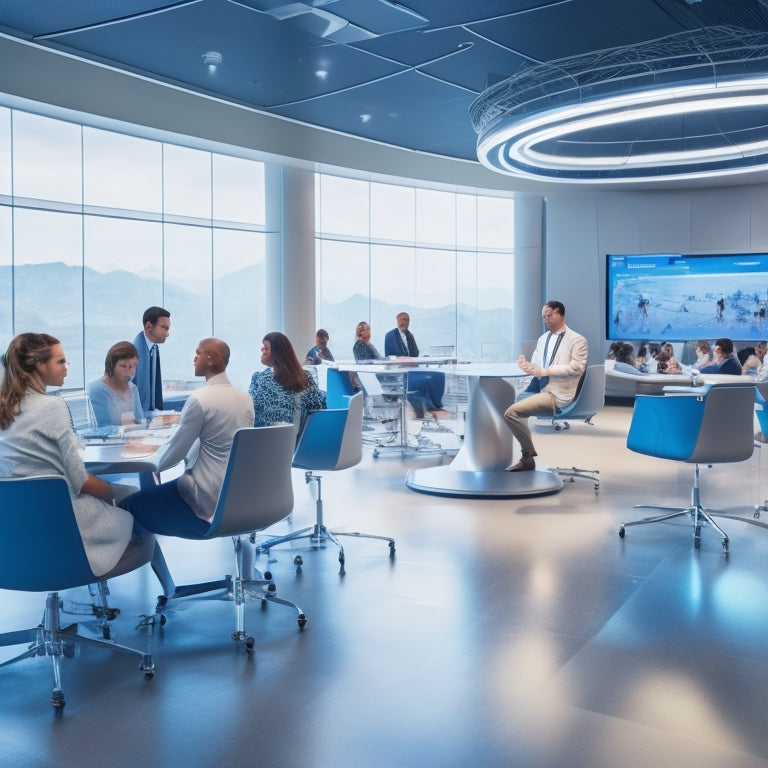
Transforming Education: Technology's Classroom Revolution
Share
The education sector is undergoing a profound transformation, driven by the potential of technology to create personalized, immersive, and inclusive learning experiences. EdTech innovations are harnessing digital power to maximize learning outcomes, foster digital literacy, and tap into the full potential of students. By integrating technology into the classroom, educators can create dynamic, interactive environments that cater to diverse learning styles. As AI, VR, and AR continue to push boundaries, the future of education looks set to be revolutionized. The possibilities are vast, and the implications are far-reaching – explore the cutting-edge developments that are shaping the classroom of tomorrow.
Key Takeaways
• EdTech innovations are transforming the learning experience by providing personalized, immersive, and interactive experiences that cater to diverse learning styles.
• Effective tech integration is crucial for creating dynamic classrooms that harness the power of AI, VR, and AR to drive advancements and improve learning outcomes.
• Digital literacy is essential for students' success in a digital world, and EdTech innovations are fostering this literacy to prepare students for their future.
• AI-powered adaptive learning is revolutionizing education by providing tailored instruction that meets unique student needs and promotes deeper understanding and improved retention.
• Seamless tech integration is empowering educators to create engaging experiences that stimulate intellectual curiosity, improve student motivation, and lead to better learning outcomes.
Embracing EdTech Innovations
As we stand at the forefront of a digital revolution in education, it is imperative that educators and administrators alike wholeheartedly embrace EdTech innovations to maximize their transformative potential in the classroom. By doing so, we can unleash the full potential of personalized learning, tailored to meet the unique needs and abilities of each student.
Additionally, EdTech innovations can foster digital literacy, empowering students with the skills necessary to thrive in an increasingly digital world. As we move forward, it is essential that we prioritize the integration of EdTech into our educational systems, ensuring that students are equipped with the skills and knowledge necessary to succeed in the 21st century.
Revolutionizing the Learning Experience
By harnessing the power of EdTech innovations, educators can now create immersive, interactive, and personalized learning experiences that captivate students' attention and stimulate their intellectual curiosity.
| Learning Style | EdTech Innovation | Impact on Learning |
|---|---|---|
| Visual | Interactive Whiteboards | Enhancing engagement, active participation |
| Auditory | Audio-based Learning Apps | Personalized learning, improved retention |
| Kinesthetic | Virtual Reality Experiences | Interactive, experiential learning |
These innovative technologies enable educators to cater to diverse learning styles, fostering a more inclusive and effective learning environment. By leveraging EdTech, educators can create dynamic, student-centered experiences that promote deeper understanding, improved retention, and enhanced engagement.
The Future of Classroom Tech
Prioritizing effective tech integration is crucial as classrooms are poised to become even more dynamic and immersive, with educators and developers continuing to push the boundaries of what is possible with innovative technologies. The future of classroom tech holds immense promise, with seamless tech integration transforming the learning landscape.
Classroom advancements will be driven by AI-powered adaptive learning, virtual and augmented reality, and advanced collaboration tools. Consequently, educators will be empowered to create personalized, interactive, and engaging experiences that cater to diverse learning styles. This will lead to improved learning outcomes, increased student motivation, and better preparation for the digital age.
Moving forward, prioritizing effective tech integration is vital to ensuring that classrooms remain at the forefront of innovation.
Frequently Asked Questions
How Do I Ensure Equal Access to Technology for All Students?
To guarantee equal access to technology, educators must address the digital divide and tech inequity by providing devices and internet access to all students, and implementing inclusive digital literacy programs that cater to diverse learning needs.
What Are the Best Strategies for Integrating Technology in Special Education?
As we bridge the gap in special education, the key to accessing inclusive learning lies in personalized approaches, leveraging accessible tools that cater to diverse needs, and harnessing technology to amplify individualized support.
Can Technology Replace Human Teachers in the Classroom?
While technology can augment teaching, it cannot replace human teachers, as Job Redundancy is unlikely; the Human Touch, empathy, and nuanced understanding that teachers provide are essential to student development and cannot be replicated by machines.
How Do I Measure the Effectiveness of Educational Technology Tools?
"Unlock the full potential of educational technology by measuring its effectiveness through a lens of learning outcomes and tool analytics, illuminating the impact on student success and informing data-driven instruction."
Are There Any Potential Drawbacks to Over-Reliance on Technology in Education?
Over-reliance on technology in education can lead to digital distractions, reducing student focus and diminishing academic performance, as well as fostering social isolation, potentially hindering essential social skills and emotional intelligence development.